The Hermetic Food Grain Storage Market is estimated to be valued at USD 1.6 billion in 2025 and is projected to reach USD 3.3 billion by 2035, registering a compound annual growth rate (CAGR) of 7.5% over the forecast period.
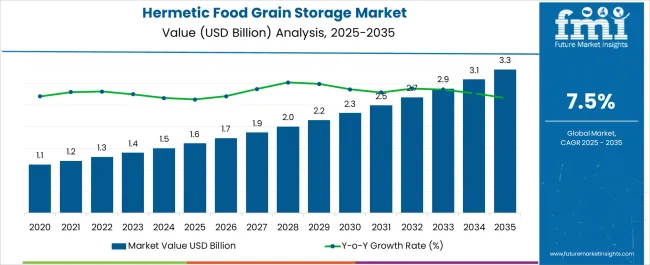
| Metric | Value |
|---|---|
| Hermetic Food Grain Storage Market Estimated Value in (2025 E) | USD 1.6 billion |
| Hermetic Food Grain Storage Market Forecast Value in (2035F) | USD 3.3 billion |
| Forecast CAGR (2025 to 2035) | 7.5% |
The Hermetic Food Grain Storage market is witnessing steady growth, driven by the increasing need to preserve food grains efficiently while minimizing post-harvest losses. Rising demand for secure, airtight storage solutions is being supported by growing awareness among farmers, cooperatives, and agri-businesses regarding grain quality preservation, pest prevention, and moisture control. Hermetic storage systems reduce reliance on chemical fumigants and enhance food safety, aligning with sustainability and regulatory compliance initiatives.
Technological improvements in materials, sealing mechanisms, and storage design are enhancing durability, ease of use, and cost-effectiveness, further encouraging adoption. Investments in agricultural infrastructure, government support programs, and growing adoption of modern storage practices are creating a favorable market environment.
The integration of hermetic storage solutions with broader post-harvest management practices, including sorting, drying, and logistics, is also contributing to efficiency As food security and supply chain optimization remain priorities globally, the Hermetic Food Grain Storage market is expected to sustain growth, with innovative storage products and scalable systems driving continued adoption across smallholder and commercial farming operations.
The hermetic food grain storage market is segmented by product type, storage capacities, application, and geographic regions. By product type, hermetic food grain storage market is divided into Hermetic Bags And Sacks, Flexible Plastic Containers, Flexible Enclosures, and Hermetic Bunkers. In terms of storage capacities, hermetic food grain storage market is classified into 50-100 Kg, Up To 1000 Tons, and Above 1000 Tons. Based on application, hermetic food grain storage market is segmented into Storage and Transportation. Regionally, the hermetic food grain storage industry is classified into North America, Latin America, Western Europe, Eastern Europe, Balkan & Baltic Countries, Russia & Belarus, Central Asia, East Asia, South Asia & Pacific, and the Middle East & Africa.
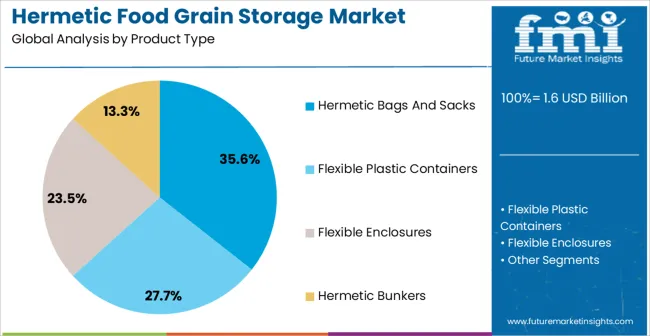
The hermetic bags and sacks product type segment is projected to hold 35.6% of the market revenue in 2025, establishing it as the leading product type. Growth is driven by their versatility, cost-effectiveness, and ability to maintain airtight conditions for prolonged periods, effectively protecting grains from moisture, pests, and microbial contamination. Their lightweight and portable nature allows for easy handling, stacking, and transport, which is particularly important for smallholder farmers and supply chain operators.
The ability to combine multiple bags to create modular storage solutions further enhances scalability and adoption. Increasing awareness about post-harvest losses and the demand for chemical-free storage solutions have reinforced preference for hermetic bags and sacks.
Technological advancements in material durability, barrier performance, and resealable closures are further improving product reliability As farmers and agribusinesses focus on preserving grain quality and extending shelf life, the hermetic bags and sacks segment is expected to maintain its leading market position, supported by growing investments in modern agricultural practices and infrastructure improvements.
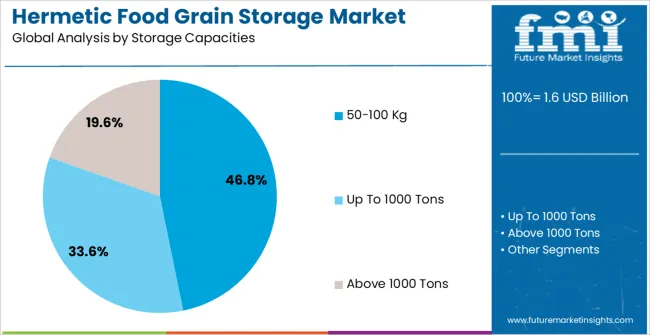
The 50-100 kg storage capacities segment is expected to account for 46.8% of the market revenue in 2025, making it the leading capacity range. This segment’s growth is driven by its suitability for both smallholder farmers and medium-scale commercial operations, providing a balance between storage volume and ease of handling. These capacities allow for efficient monitoring and management of grain quality while minimizing the risk of spoilage.
Hermetic systems in this capacity range facilitate modular stacking, transport, and distribution, which is essential for optimizing supply chains and reducing post-harvest losses. Adoption is further supported by affordability, durability, and compatibility with a variety of grain types, including cereals, legumes, and pulses.
As awareness of post-harvest losses and food security continues to rise, 50-100 kg storage solutions are being increasingly preferred for their practicality and effectiveness The segment is expected to maintain leadership due to its versatility, operational convenience, and ability to support modern storage practices across both rural and commercial settings.
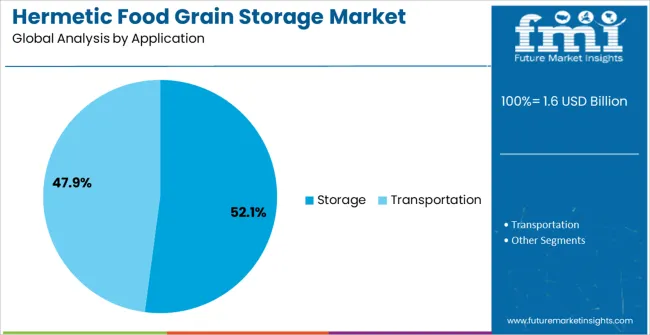
The storage application segment is projected to hold 52.1% of the market revenue in 2025, establishing it as the leading application area. Growth is driven by the critical need to preserve grains safely over long periods, ensuring food quality, reducing spoilage, and maintaining nutritional value. Hermetic storage systems provide airtight conditions that limit oxygen exposure, prevent pest infestations, and reduce moisture accumulation, supporting food security initiatives.
Adoption is being accelerated by the rising focus on post-harvest management practices and modern agricultural infrastructure development. Farmers and agribusinesses increasingly prefer hermetic storage solutions for their reliability, durability, and scalability across small, medium, and large operations.
The ability to maintain grain quality during transportation and storage, coupled with compliance with regulatory standards and sustainability objectives, further reinforces adoption As the global population grows and demand for secure food storage rises, the storage segment is expected to remain the primary driver of market growth, supported by technological innovation and the widespread adoption of hermetic storage solutions in both rural and commercial settings.
The way of storing food grains has evolved in recent years. From traditional way of storing food grains, people are moving towards hermetic storage. This method was first introduced in the 1980s. Hermetic food grain storage method is now replacing traditional post-harvest storage method. The term hermetic means air tight seal, which is impermeable to air flow. To prevent spoilage attack of insects, hermetic food grain storage came into existence.
Many countries around the globe are opting for this method of storing grains and different commodities such as rice, maize, wheat, pulses, seeds, and cocoa, among others. In addition, hermetic storage is used for intercontinental shipments to transfer a variety of commodities. Hermetic storage is typically necessary in tropical and semi-tropical areas having high humidity and temperature.
Hermetic food grain storage includes various kinds of containers such as flexible plastic containers, flexible enclosures and hermetic bunkers. They all vary in capacities, ranging from a few kilograms to thousands of tons. As hermetic storage reduces flow of air in and out of it, a low oxygen atmosphere is created, and hence storage loss is reduced to minimal.
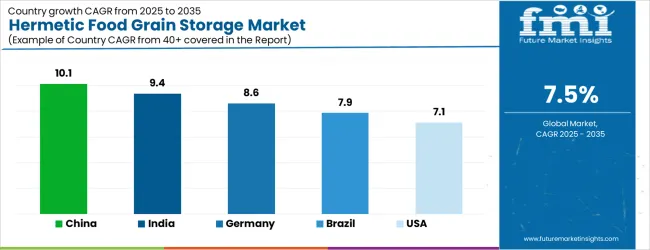
| Country | CAGR |
|---|---|
| China | 10.1% |
| India | 9.4% |
| Germany | 8.6% |
| Brazil | 7.9% |
| USA | 7.1% |
| UK | 6.4% |
| Japan | 5.6% |
The Hermetic Food Grain Storage Market is expected to register a CAGR of 7.5% during the forecast period, exhibiting varied country level momentum. China leads with the highest CAGR of 10.1%, followed by India at 9.4%. Developed markets such as Germany, France, and the UK continue to expand steadily, while the USA is likely to grow at consistent rates. Japan posts the lowest CAGR at 5.6%, yet still underscores a broadly positive trajectory for the global Hermetic Food Grain Storage Market.
In 2024, Germany held a dominant revenue in the Western Europe market and is expected to grow with a CAGR of 8.6%. The USA Hermetic Food Grain Storage Market is estimated to be valued at USD 570.0 million in 2025 and is anticipated to reach a valuation of USD 570.0 million by 2035. Sales are projected to rise at a CAGR of 0.0% over the forecast period between 2025 and 2035. While Japan and South Korea markets are estimated to be valued at USD 87.1 million and USD 49.1 million respectively in 2025.
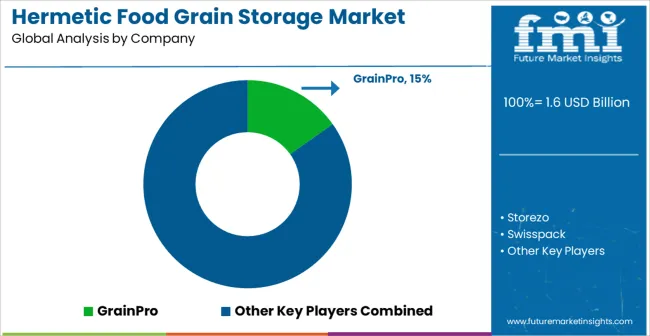
| Item | Value |
|---|---|
| Quantitative Units | USD 1.6 Billion |
| Product Type | Hermetic Bags And Sacks, Flexible Plastic Containers, Flexible Enclosures, and Hermetic Bunkers |
| Storage Capacities | 50-100 Kg, Up To 1000 Tons, and Above 1000 Tons |
| Application | Storage and Transportation |
| Regions Covered | North America, Europe, Asia-Pacific, Latin America, Middle East & Africa |
| Country Covered | United States, Canada, Germany, France, United Kingdom, China, Japan, India, Brazil, South Africa |
| Key Companies Profiled | GrainPro, Storezo, Swisspack, Ecotact, Vestergaard, Silo Bag India Private Limited, Big John Manufacturing, Plastika Kritis, Rishi FIBC Solutions, Qingdao Jintiandi Plastic Packaging Co, GreenPak, Envocrystal, A to Z Textile Mills, Elite Innovations, and Save Grain Advanced Solutions Pvt Ltd |
The global hermetic food grain storage market is estimated to be valued at USD 1.6 billion in 2025.
The market size for the hermetic food grain storage market is projected to reach USD 3.3 billion by 2035.
The hermetic food grain storage market is expected to grow at a 7.5% CAGR between 2025 and 2035.
The key product types in hermetic food grain storage market are hermetic bags and sacks, flexible plastic containers, flexible enclosures and hermetic bunkers.
In terms of storage capacities, 50-100 kg segment to command 46.8% share in the hermetic food grain storage market in 2025.






Our Research Products

The "Full Research Suite" delivers actionable market intel, deep dives on markets or technologies, so clients act faster, cut risk, and unlock growth.

The Leaderboard benchmarks and ranks top vendors, classifying them as Established Leaders, Leading Challengers, or Disruptors & Challengers.

Locates where complements amplify value and substitutes erode it, forecasting net impact by horizon

We deliver granular, decision-grade intel: market sizing, 5-year forecasts, pricing, adoption, usage, revenue, and operational KPIs—plus competitor tracking, regulation, and value chains—across 60 countries broadly.

Spot the shifts before they hit your P&L. We track inflection points, adoption curves, pricing moves, and ecosystem plays to show where demand is heading, why it is changing, and what to do next across high-growth markets and disruptive tech

Real-time reads of user behavior. We track shifting priorities, perceptions of today’s and next-gen services, and provider experience, then pace how fast tech moves from trial to adoption, blending buyer, consumer, and channel inputs with social signals (#WhySwitch, #UX).

Partner with our analyst team to build a custom report designed around your business priorities. From analysing market trends to assessing competitors or crafting bespoke datasets, we tailor insights to your needs.
Supplier Intelligence
Discovery & Profiling
Capacity & Footprint
Performance & Risk
Compliance & Governance
Commercial Readiness
Who Supplies Whom
Scorecards & Shortlists
Playbooks & Docs
Category Intelligence
Definition & Scope
Demand & Use Cases
Cost Drivers
Market Structure
Supply Chain Map
Trade & Policy
Operating Norms
Deliverables
Buyer Intelligence
Account Basics
Spend & Scope
Procurement Model
Vendor Requirements
Terms & Policies
Entry Strategy
Pain Points & Triggers
Outputs
Pricing Analysis
Benchmarks
Trends
Should-Cost
Indexation
Landed Cost
Commercial Terms
Deliverables
Brand Analysis
Positioning & Value Prop
Share & Presence
Customer Evidence
Go-to-Market
Digital & Reputation
Compliance & Trust
KPIs & Gaps
Outputs
Full Research Suite comprises of:
Market outlook & trends analysis
Interviews & case studies
Strategic recommendations
Vendor profiles & capabilities analysis
5-year forecasts
8 regions and 60+ country-level data splits
Market segment data splits
12 months of continuous data updates
DELIVERED AS:
PDF EXCEL ONLINE
Food Storage Container Market Size and Share Forecast Outlook 2025 to 2035
Food Storage Bags Market Trends - Demand & Forecast 2025 to 2035
Grain-Free Pet Food Market Trends - Growth & Industry Forecast 2024 to 2034
Silicone Food Storage Bag Market Insights – Demand & Forecast 2024-2034
Whole Grain & High Fiber Foods Market Growth – Demand, Trends & Forecast 2025–2035
United Kingdom Whole Grain and High Fiber Foods Market Report – Trends & Forecast 2025–2035
United States Whole Grain and High Fiber Foods Market Report – Trends & Forecast 2025–2035
Europe Whole Grain and High Fiber Foods Market Insights – Size & Forecast 2025–2035
Asia Pacific Whole Grain and High Fiber Foods Market Outlook – Size, Share & Forecast 2025–2035
Grain Hardness Meter Market Size and Share Forecast Outlook 2025 to 2035
Grain Cooling Spear Market Size and Share Forecast Outlook 2025 to 2035
Food & Beverage OEE Software Market Size and Share Forecast Outlook 2025 to 2035
Food Grade Crosslinked Polyvinylpolypyrrolidone (PVPP) Market Size and Share Forecast Outlook 2025 to 2035
Food Grade Cassia Gum Powder Market Size and Share Forecast Outlook 2025 to 2035
Food Grade Dry Film Lubricant Market Size and Share Forecast Outlook 2025 to 2035
Foodservice Equipment Market Analysis - Size, Share, and Forecast Outlook 2025 to 2035
Food Basket Market Forecast and Outlook 2025 to 2035
Food Grade Tremella Polysaccharide Market Size and Share Forecast Outlook 2025 to 2035
Food Sorting Machine Market Size and Share Forecast Outlook 2025 to 2035
Foodservice Paper Bag Market Size and Share Forecast Outlook 2025 to 2035

Thank you!
You will receive an email from our Business Development Manager. Please be sure to check your SPAM/JUNK folder too.
Chat With
MaRIA